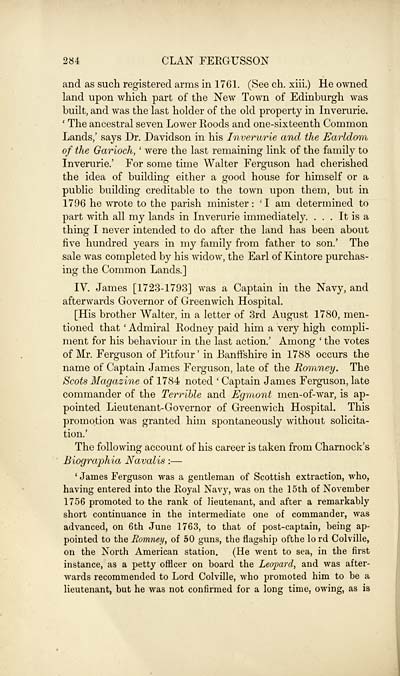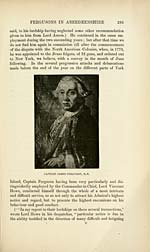Download files
Complete book:
Individual page:
Thumbnail gallery: Grid view | List view

284 CLAN" FERGUSSON
and as such registered arms in 1761. (See ch. xiii.) He owned
land upon which part of the New Town of Edinburgh was
built, and was the last holder of the old property in Inverurie.
' The ancestral seven Lower Roods and one-sixteenth Common
Lands/ says Dr. Davidson in his Inverurie and the Earldom
of the Garioch, ' were the last remaining link of the family to
Inverurie.' For some time Walter Ferguson had cherished
the idea of building either a good house for himself or a
public building creditable to the town upon them, but in
1796 he wrote to the parish minister: I am determined to
part with all my lands in Inverurie immediately. . . . It is a
thing I never intended to do after the land has been about
five hundred years in my family from father to son.' The
sale was completed by his widow, the Earl of Kintore purchas-
ing the Common Lands.]
IV. James [1723-1793] was a Captain in the Navy, and
afterwards Governor of Greenwich Hospital.
[His brother Walter, in a letter of 3rd August 1780, men-
tioned that ' Admiral Rodney paid him a very high compli-
ment for his behaviour in the last action.' Among ' the votes
of Mr. Ferguson of Pitfour ' in Banffshire in 1788 occurs the
name of Captain James Ferguson, late of the Romney. The
Scots Magazine of 1784 noted ' Captain James Ferguson, late
commander of the Terrible and Egmont men-of-war, is ap-
pointed Lieutenant-Governor of Greenwich Hospital. This
promotion was granted him spontaneously without solicita-
tion.'
The following account of his career is taken from Charnock's
Biographia Navalis : —
' James Ferguson was a gentleman of Scottish extraction, who,
having entered into the Royal Navy, was on the 15th of November
1756 promoted to the rank of Keutenant, and after a remarkably
short continuance in the intermediate one of commander, was
advanced, on 6th June 1763, to that of post-captain, being ap-
pointed to the Romney, of 50 guns, the flagship ofthe lo rd Colville,
on the North American station. (He went to sea, in the first
instance, as a petty officer on board the Leopard, and was after-
wards recommended to Lord Colville, who promoted him to be a
lieutenant, but he was not confirmed for a long time, owing, as is
and as such registered arms in 1761. (See ch. xiii.) He owned
land upon which part of the New Town of Edinburgh was
built, and was the last holder of the old property in Inverurie.
' The ancestral seven Lower Roods and one-sixteenth Common
Lands/ says Dr. Davidson in his Inverurie and the Earldom
of the Garioch, ' were the last remaining link of the family to
Inverurie.' For some time Walter Ferguson had cherished
the idea of building either a good house for himself or a
public building creditable to the town upon them, but in
1796 he wrote to the parish minister: I am determined to
part with all my lands in Inverurie immediately. . . . It is a
thing I never intended to do after the land has been about
five hundred years in my family from father to son.' The
sale was completed by his widow, the Earl of Kintore purchas-
ing the Common Lands.]
IV. James [1723-1793] was a Captain in the Navy, and
afterwards Governor of Greenwich Hospital.
[His brother Walter, in a letter of 3rd August 1780, men-
tioned that ' Admiral Rodney paid him a very high compli-
ment for his behaviour in the last action.' Among ' the votes
of Mr. Ferguson of Pitfour ' in Banffshire in 1788 occurs the
name of Captain James Ferguson, late of the Romney. The
Scots Magazine of 1784 noted ' Captain James Ferguson, late
commander of the Terrible and Egmont men-of-war, is ap-
pointed Lieutenant-Governor of Greenwich Hospital. This
promotion was granted him spontaneously without solicita-
tion.'
The following account of his career is taken from Charnock's
Biographia Navalis : —
' James Ferguson was a gentleman of Scottish extraction, who,
having entered into the Royal Navy, was on the 15th of November
1756 promoted to the rank of Keutenant, and after a remarkably
short continuance in the intermediate one of commander, was
advanced, on 6th June 1763, to that of post-captain, being ap-
pointed to the Romney, of 50 guns, the flagship ofthe lo rd Colville,
on the North American station. (He went to sea, in the first
instance, as a petty officer on board the Leopard, and was after-
wards recommended to Lord Colville, who promoted him to be a
lieutenant, but he was not confirmed for a long time, owing, as is
Set display mode to:
![]() Universal Viewer |
Universal Viewer | ![]() Mirador |
Large image | Transcription
Mirador |
Large image | Transcription
Images and transcriptions on this page, including medium image downloads, may be used under the Creative Commons Attribution 4.0 International Licence unless otherwise stated. ![]()
| Histories of Scottish families > Records of the clan and name of Fergusson, Ferguson and Fergus > (330) Page 284 |
|---|
| Permanent URL | https://digital.nls.uk/95330123 |
|---|
| Description | A selection of almost 400 printed items relating to the history of Scottish families, mostly dating from the 19th and early 20th centuries. Includes memoirs, genealogies and clan histories, with a few produced by emigrant families. The earliest family history goes back to AD 916. |
|---|

